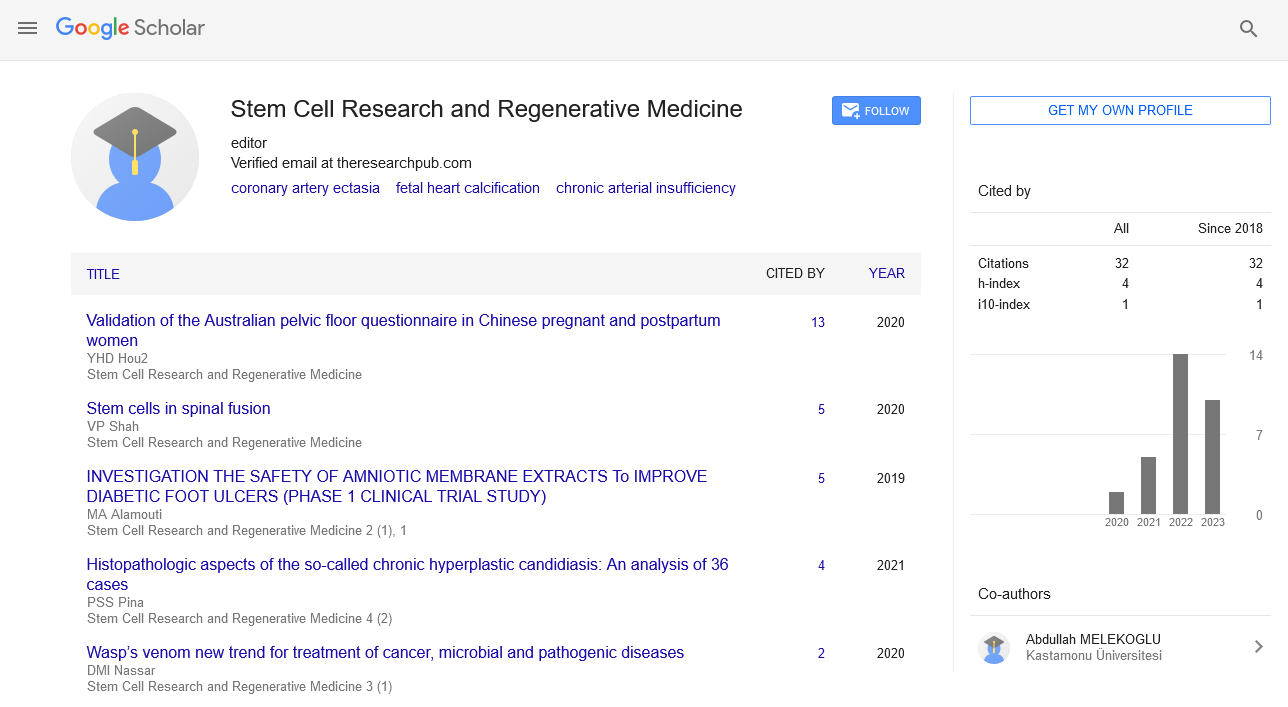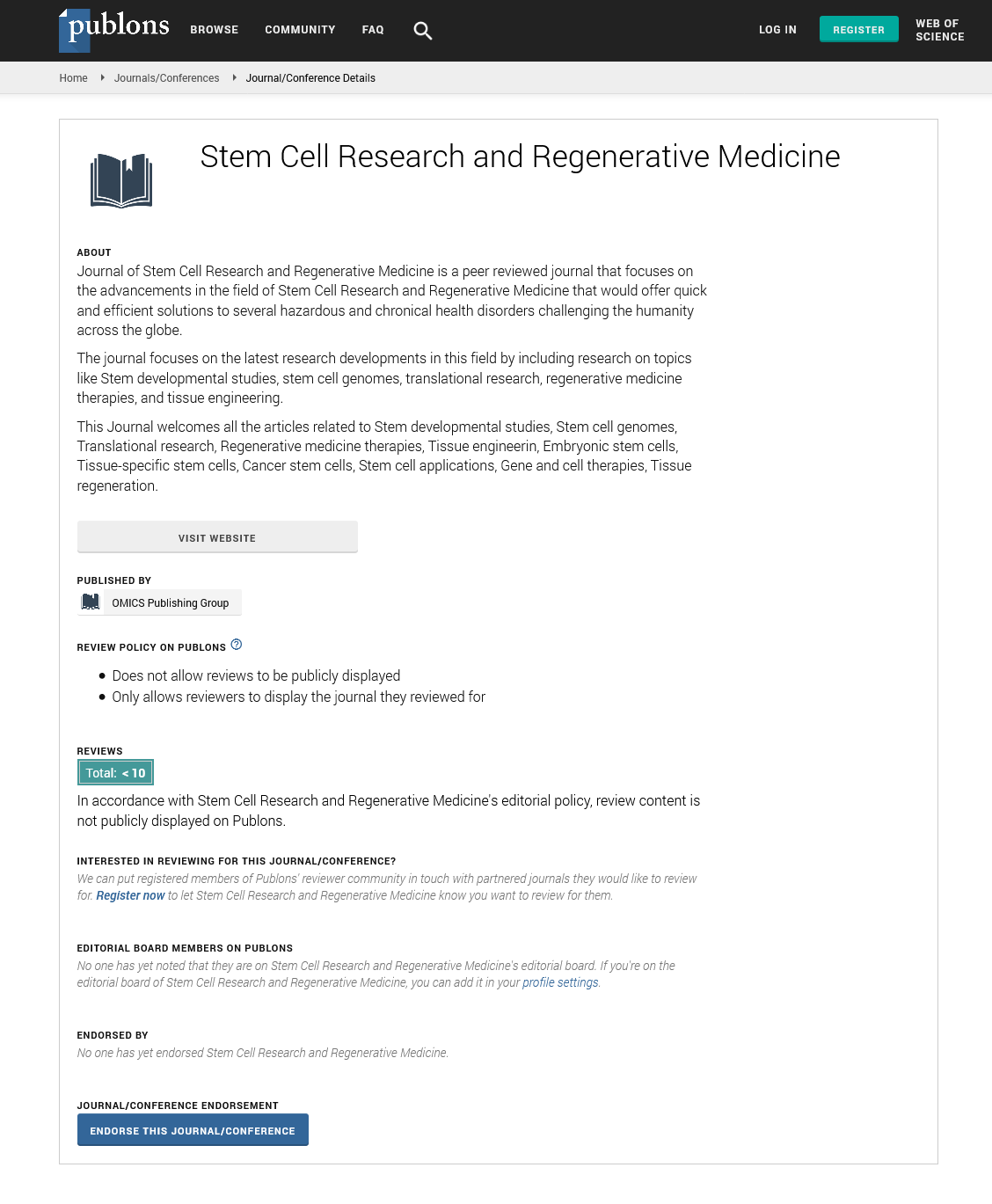Perspective - Stem Cell Research and Regenerative Medicine (2024) Volume 7, Issue 6
Stem Cell-Based Therapies: Hope for Parkinsonâ≢s, Alzheimerâ≢s, and Spinal Cord Injuries
- Corresponding Author:
- Shengli Chen
Department of Stem Cell Research, Ilisimatusarfik University, Manutooq 1, 3905, Nuuk 3905, Greenland
E-mail: chenshengli@gmail.com
Received: 02-Dec-2024, Manuscript No. SRRM-24-153861; Editor assigned: 04-Dec-2024, Pre QC No. SRRM-24-153861 (PQ); Reviewed: 16-Dec-2024, QC No. SRRM-24-153861; Revised: 23-Dec-2024, Manuscript No. SRRM-24-153861 (R); Published: 31-Dec-2024, DOI: 10.37532/SRRM.2024.7(6).278-280
Introduction
Stem cell-based therapies hold significant promise for treating neurodegenerative disorders and traumatic injuries, particularly conditions like Parkinson’s disease, Alzheimer’s disease, and spinal cord injuries. These conditions have long been considered difficult, if not impossible, to reverse due to the limited regenerative capacity of the central nervous system. However, the unique ability of stem cells to differentiate into various cell types and regenerate damaged tissues offers a new avenue for developing effective treatments. The exploration of stem cell-based interventions marks a shift from traditional symptom management to potential regenerative therapies that could restore lost functions and improve the quality of life for millions.
Description
In Parkinson’s disease, the loss of dopamine-producing neurons in the substantia nigra leads to the characteristic motor symptoms, including tremors, rigidity, and bradykinesia. Conventional treatments, such as levodopa and dopamine agonists, are primarily aimed at managing symptoms but do not halt disease progression. Stem cell-based therapies are being explored as a way to replace the lost neurons and restore dopamine production in the brain. Several studies have shown that stem cells, particularly induced Pluripotent Stem Cells (iPSCs) and Mesenchymal Stem Cells (MSCs), can be coaxed into differentiating into dopaminergic neurons. Transplantation of these cells into animal models of Parkinson’s has demonstrated improvements in motor function and dopamine levels, fueling optimism for human trials. In recent years, clinical trials using iPSC-derived dopaminergic neurons have been initiated, and early results are encouraging, suggesting that stem cell therapies could become a viable treatment option for Parkinson’s disease.
One of the major challenges in developing stem cell therapies for Parkinson’s is ensuring the long-term survival, integration, and function of transplanted cells. The brain’s environment can be hostile to newly introduced cells due to factors like inflammation, oxidative stress, and the presence of alpha-synuclein aggregates, which are hallmarks of the disease. Researchers are investigating ways to enhance the engraftment of stem cells by pre-conditioning them, using neuroprotective agents, or co-administering supportive factors to create a more favorable environment for cell survival. Additionally, advances in gene editing technologies, such as CRISPR-Cas9, offer the possibility of modifying stem cells to make them more resistant to the pathological conditions present in Parkinson’s disease, thereby improving the efficacy of transplantation.
Alzheimer’s disease presents a more complex challenge for stem cell-based therapies due to its multifactorial nature and widespread neurodegeneration. The progressive loss of neurons, particularly in regions associated with memory and cognition, leads to severe cognitive decline and dementia. While current treatments focus on managing symptoms, such as memory loss and agitation, they do not address the underlying causes of neuronal death. Stem cells, especially Neural Stem Cells (NSCs) and iPSCs, offer a potential strategy for replacing lost neurons and restoring cognitive function. Research has shown that stem cells can differentiate into various neuronal subtypes, including cholinergic neurons, which are heavily affected in Alzheimer’s disease. These cells can potentially replace damaged neurons, secrete neurotrophic factors, and modulate the immune response to reduce inflammation and amyloid-beta accumulation.
The complex pathology of Alzheimer’s requires a multi-faceted approach, and stem cell-based therapies are being developed in combination with other strategies. For example, stem cells engineered to express anti-amyloid or anti-tau antibodies could help clear the pathological proteins that accumulate in the brains of Alzheimer’s patients. Additionally, research into using stem cells to deliver therapeutic molecules directly to affected areas of the brain is gaining traction. This targeted delivery could enhance the effectiveness of treatments and minimize systemic side effects. However, the blood-brain barrier remains a significant hurdle, limiting the delivery of stem cells and therapeutic agents to the central nervous system. Overcoming this barrier through the use of nanotechnology, focused ultrasound, or direct intracerebral injection may improve the success of stem cell therapies for Alzheimer’s.
Spinal cord injuries are another area where stem cell-based therapies offer hope. Damage to the spinal cord can result in paralysis, sensory loss, and impaired autonomic function, depending on the location and severity of the injury. The lack of effective regenerative therapies has left many patients with limited treatment options, focusing mainly on rehabilitation and symptom management. Stem cells, particularly Neural Stem Cells (NSCs), Embryonic Stem Cells (ESCs), and MSCs, are being explored for their potential to repair and regenerate damaged spinal cord tissue. In preclinical studies, transplantation of stem cells into animal models of spinal cord injury has shown promising results, including improved motor function, remyelination of damaged axons, and reduced scar tissue formation.
The mechanisms by which stem cells promote recovery after spinal cord injury are still being elucidated. Stem cells can differentiate into various cell types, including neurons, oligodendrocytes, and astrocytes, contributing directly to the replacement of lost cells. Additionally, stem cells secrete a range of bioactive factors, such as growth factors, cytokines, and exosomes, which can modulate the immune response, reduce inflammation, and promote tissue repair. The ability of stem cells to create a supportive microenvironment for endogenous repair mechanisms is a crucial aspect of their therapeutic potential. Clinical trials involving stem cell transplantation for spinal cord injuries are currently underway, and some have reported modest improvements in motor and sensory function, raising hopes that more refined and effective therapies will be developed in the coming years.
One of the significant concerns with stem cell-based therapies, particularly for neurodegenerative diseases and spinal cord injuries, is safety. The risk of tumorigenesis, immune rejection, and unwanted differentiation into inappropriate cell types must be carefully managed. Ensuring the purity, stability, and safety of stem cells before transplantation is paramount. Rigorous preclinical testing, including long-term follow-up studies in animal models, is essential to minimize the risks associated with stem cell therapies. Additionally, the ethical considerations surrounding the use of embryonic stem cells have led to the exploration of alternative sources, such as iPSCs, which can be derived from adult cells and offer similar pluripotent capabilities without the associated ethical dilemmas.
The scalability and standardization of stem cell production also pose challenges for the widespread adoption of these therapies. Manufacturing large quantities of high-quality stem cells that meet regulatory standards is a complex and costly process. Variability in cell quality, differentiation potential, and engraftment efficiency can affect the outcome of stem cell therapies, emphasizing the need for standardized protocols and stringent quality control measures. The development of automated cell culture systems, bioreactors, and advanced imaging technologies for monitoring cell behavior are some of the approaches being explored to address these challenges and improve the reproducibility of stem cell-based interventions.
Another area of active research is the combination of stem cell therapies with other regenerative techniques, such as biomaterials and bioengineering. The use of scaffolds, hydrogels, and nanomaterials to support stem cell delivery and enhance tissue regeneration is gaining attention. These materials can provide structural support, promote cell adhesion, and release bioactive molecules to guide cell differentiation and tissue repair. In the case of spinal cord injuries, 3D-printed scaffolds loaded with stem cells have shown potential in bridging gaps in the damaged spinal cord and providing a conducive environment for axonal regeneration. The integration of stem cells with advanced biomaterials could lead to more effective therapies that improve functional recovery and reduce the long-term consequences of neurodegeneration and injury.
The field of stem cell-based therapies is still in its infancy, and the journey from preclinical studies to clinical applications is filled with challenges. However, the progress made over the past few decades has been remarkable, and several clinical trials are underway to evaluate the safety and efficacy of stem cell therapies for conditions like Parkinson’s, Alzheimer’s, and spinal cord injuries. These trials are crucial in determining the therapeutic potential of stem cells, identifying the most effective cell types and delivery methods, and addressing the technical and ethical challenges that remain.
Conclusion
stem cell-based therapies offer a beacon of hope for patients with neurodegenerative disorders and spinal cord injuries, conditions that currently lack effective cures. While the challenges are substantial, the potential rewards are equally significant. The ability to regenerate lost or damaged tissue, restore neural function, and improve the quality of life for millions of individuals makes stem cell research a critical area of exploration. Continued investment in basic research, clinical trials, and technological innovations will be essential in unlocking the full potential of stem cell-based therapies. As our understanding of stem cell biology and regenerative medicine advances, the possibility of developing transformative treatments for some of the most debilitating conditions in medicine moves closer to reality. The future of stem cell-based therapies holds promise not only for restoring lost functions but also for reshaping our approach to treating chronic diseases and injuries, offering hope where there was once none.


